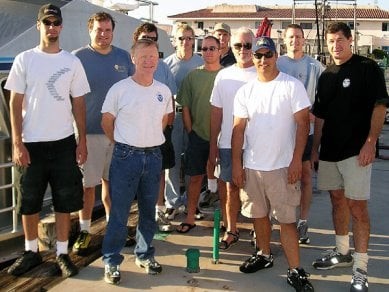The Cambrian Foundation was asked to assist the United States National Oceanic and Atmospheric Administration, NOAA, in recovering a multibeam sonar head, MSH, that was lost in over 250 feet of water while surveying underwater topography at Cortez Banks, 100 miles off the coast of Southern California, USA.
The project would require the cooperative effort of several agencies. NOAA Fisheries, NOAA Channel Islands National Marine Sanctuary, NOAA Dive Office, California Fish and Game, California State University Monterey Bay, and the Cambrian Foundation all aided in the successful recovery of the device from 269 feet of water. The device was returned to CSUMonterey Bay for inspection and repair. When the sonar was plugged back in, it actually worked!
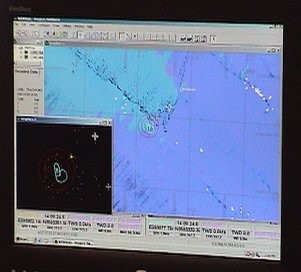 The device was lost in July. Time was critical. The longer the delay from MSH loss to recovery, the less the chance for recovery and the higher the chances for damage to the head, if found. The project came together in unprecedented time.
The device was lost in July. Time was critical. The longer the delay from MSH loss to recovery, the less the chance for recovery and the higher the chances for damage to the head, if found. The project came together in unprecedented time.
Initial discussion began in August. NOAA CINMS provided the RV Shearwater as the principal operations vessel and to house the crew. CFG provided the MV Swordfish as a support vessel. NOAA Fisheries provided the Remotely Operated Vehicle, ROV, to search for the head. The Cambrian Foundation provided the dive team to recover the device.
The NOAA Dive Office approved the dive plan and secured DCAP dive tables for trimix 14/60 (14% oxygen, 60% helium and the balance made up of nitrogen) from Dr. Bill Hamilton. All players came together to allow the project to go forward on very short notice. This was a cooperative effort by everyone involved.
All divers utilized technical diving techniques to perform recovery operations. Karl Shreeves and Steve Mortell made up the bottom team, Tim Gallagher was the Diving Safety Officer, Jeff Schoonover was shallow support and Grant Graves was deep support and project director.
Friday Sept. 5, 2003
The Cambrian Foundation team congregated at Malibu Divers (www.malibudivers.com) in Malibu, California at 1pm. Final gas fills and top ups were performed. The lifting apparatus and hardware was setup and tested. The bottom team, Karl Shreeves and Steve Mortell, walked through the lift procedures for the MSH with the Project Diving Safety Officer, Tim Galhgar, and the Project Director, Grant Graves.
Once everything was completed the team left to meet the NOAA team in Ventura Harbor, Ca, USA at the fuel dock. The team arrived at Ventura at 5pm; the MV Swordfish was pulling into the fuel dock. The Swordfish is a California Fish and Game petrol vessel. NOAA had arranged with the Swordfish to assist in the project. This was an unexpected surprise. The team was able to pre-stage decompression cylinders on the Swordfish for the project. Tim was able to pre-brief the crew of the Swordfish (Lt. John Suchil, Capt., Warden Santos Cabral and Warden Robert Walther) regarding support operations for the dive.
The NOAA research vessel RV Shearwater arrived an hour later. The team loaded their gear on the Shearwater and prepared for the transit to Cortez Banks.
Saturday, Sept. 6, 2003
The Shearwater arrived on site at Cortez Banks at 6am. The ROV crew (John Butler, Ph.D., John Wagner and Anthony Cossio) began preparations for launching their ROV. The crew worked diligently through several electronics problems. Murphy has to get his cut every time. The ROV would be used to relocate the sonar head and provide a down line for the bottom team to reach the head. Of course, that is if the head was where it was thought to be. After six weeks underwater, the odds of finding it were slim.
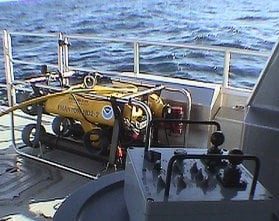 The dive team was on hold until the ROV could do its job. The dive team made final gas analysis and prepared gear as best they could. Tim helped the ROV crew launch and recover the ROV. The team joked that it felt like a place kicker on an American football team, in the way until really needed. Then, very important when needed. Sea conditions were good with swells three to four feet. This is definitely not bad when you are 100 miles out to sea.
The dive team was on hold until the ROV could do its job. The dive team made final gas analysis and prepared gear as best they could. Tim helped the ROV crew launch and recover the ROV. The team joked that it felt like a place kicker on an American football team, in the way until really needed. Then, very important when needed. Sea conditions were good with swells three to four feet. This is definitely not bad when you are 100 miles out to sea.
The ROV crew managed to launch the ROV successfully after one failed attempt. It was 2pm. As the Shearwater motored at one knot to the last know location of the sonar head, the Cambrian Team gathered around the video screen of the ROV. The ROV was on the bottom and the search began. Sand, sand and more sand. 265 feet and nothing but sand. Everywhere the ROV looked the same story, SAND. Of course, that is good when you are looking for something man made. It will stick out like a sore thumb. That is if the head is not buried in the sand. The ROV has technology that can deal with that, onboard sonar.
As the captain called out the last know point of telemetry given by the head before its connection was severed six weeks earlier, all of those watching the video screen asked the same question, “What is that?” Sure enough, right as the Shearwater reached the last known point, the ROV found the Sonar Head. It was sitting in 269 feet of water; literally directly below the spot it was lost off the vessel using it. “This just does not happen.” You could hear the sound of disbelief in the voices of all onboard the Shearwater.
It was time for the dive team to go to work. First order of business was to call the MV Swordfish. They happened to be at Tanner Banks seven miles away, estimated time of arrival, ETA, twenty minutes. “We are a go.” Tim yelled. It was getting late and the sea condition was headed south. If the Swordfish had been further away the day would have been over. The crew’s heads up position was a big link in the success of the project.
The dive team made final gear preparations. The bottom team prepared dive tables now that the bottom depth was known. The Shearwater launched its inflatable, piloted by Dana Wilkes, to recover the head once it arrived on the surface.
The Swordfish arrived from Tanner Banks and launched its own inflatable. Warden Santos Cabral and Robert Walther manned the skiff while Capt. John Suchil stayed at the helm of the Swordfish.
The support divers prepared to load on to the launch from the MV Swordfish. Once Jeff and Grant were on the support boat they donned their backup stages. Ready to enter the water in the event of an emergency or as planned when the bottom team’s liftbags hit the surface.
Karl and Steve prepared to depart the Shearwater. Armed with two hundred pounds of dive equipment plus the lifting equipment, the bottom team held at the back of the pitching Shearwater waiting for the signal from Tim to dive. “Dive, dive, dive” Tim called out after the captain put the screws of the Shearwater in neutral. At approximately 4pm, the bottom team splashed on the ROV cable and made a negatively buoyant descent toward the bottom.
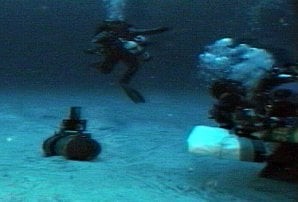 Tim called, “Clear!” after the bottom team was deep enough for the Shearwater to restart operations in order to maintain station with the ROV. The bottom team was prepared to abort descent, if needed to ascend away from the Shearwater’s screws. The bottom team reached the bottom in approximately three minutes. They quickly went to work. In three minutes, the sonar head was secured and on its way to the surface attached to a closed cell commercial liftbag.
Tim called, “Clear!” after the bottom team was deep enough for the Shearwater to restart operations in order to maintain station with the ROV. The bottom team was prepared to abort descent, if needed to ascend away from the Shearwater’s screws. The bottom team reached the bottom in approximately three minutes. They quickly went to work. In three minutes, the sonar head was secured and on its way to the surface attached to a closed cell commercial liftbag.
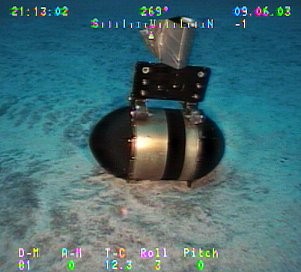 The bag was secured to the sonar head with heavy-duty cable with eyes looped in both ends. The divers looped the cable through the broken attachment fixtures on the sonar head and back on to itself. Then, they secured the cable to the liftbag with a stainless steel locking carabineer. A separate small air cylinder was clipped to the liftbag and triggered to fill the bag. Away it went. The sonar head reached the surface approximated ten minutes after the bottom team entered the water.
The bag was secured to the sonar head with heavy-duty cable with eyes looped in both ends. The divers looped the cable through the broken attachment fixtures on the sonar head and back on to itself. Then, they secured the cable to the liftbag with a stainless steel locking carabineer. A separate small air cylinder was clipped to the liftbag and triggered to fill the bag. Away it went. The sonar head reached the surface approximated ten minutes after the bottom team entered the water.
The bottom team did not delay their departure from the bottom. Once their job was done, they drifted off the bottom shortly after six minutes. The dive plan called for a drifting decompression. The bottom team shot a liftbag to the surface from depth. Once the bag reached the surface, a second bag was shot to signal that both team members were together.
The support divers were splashed on the decompression bags at approximately 15 minutes into the dive. Both divers were together and fine. They signaled that they were okay and on a 270 feet table with a bottom time of ten minutes. The information was relayed to the surface, so that all would be aware that the divers were fine. Decompression was uneventful. The divers reached the surface an hour after entering.
Surface conditions had deteriorated considerably in that hour. All divers passed their stages to the skiff from the Swordfish. The Shearwater had recovered the ROV while the divers were decompressing. The Shearwater made its way to recover the divers. The seas were too rough to recover the divers with their kits on, so each diver removed their doubles prior to exiting the water. The doubles were handed off to the crew on the Shearwater and the divers pulled out of the water on the opposite side of the aft deck of the Shearwater.
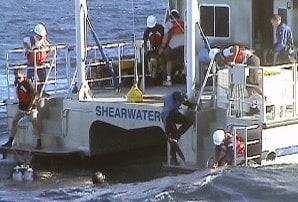 All divers were safely recovered. The MSH was secure on the boat. It was now 5:20pm. If any part of the operation were delayed, the dive never would have happened. Conditions were going from bad to worse. It was not likely that it would improve the following day. Everyone was glad that it all came together when it did.
All divers were safely recovered. The MSH was secure on the boat. It was now 5:20pm. If any part of the operation were delayed, the dive never would have happened. Conditions were going from bad to worse. It was not likely that it would improve the following day. Everyone was glad that it all came together when it did.
The Swordfish and Shearwater recovered their skiffs and both vessels began the long ride home. Seas continued to build. Several members of the crew did not fair as well with seasickness as they did with the mission, but all were beside themselves with the success of the team effort.
Sunday Sept. 7, 2003
The Shearwater arrived in port at 2am. The team was long asleep on board. In the morning, the Cambrian Team unloaded all their gear and said their final goodbyes.
Karl summed up the project by stating, “. The project overall was an example of being prepared for problems, but having everything not simply go as planned, but going better than planned and being prepared to take advantage of the opportunities.”
The Cambrian Foundation, formed in 1994, is a nonprofit corporation based in Winter Park, FL, USA. The Foundation is dedicated to conducting scientific research, preservation, exploration, and education of the aquatic realm. The Foundation shares this knowledge, bringing awareness and insight to the community about their connection with their aquatic and oceanic resources. If you would like to learn more about the foundation check out cambrianfoundation.org.
The Cambrian Foundation would like to thank all those involved with the project.
Cambrian Foundation Team
Tim Gallagher – Project Diving Safety Officer
Karl Shreeves – Bottom Diver
Steve Mortell – Bottom Diver
Jeff Schoonover – Support Diver
Grant Graves – Support Diver and Project Director
NOAA National Marine Sanctuary Program
Dana Wilkes – NOAA MSH Project Coordinator
NOAA Fisheries
LCDR Scott Hill
Melissa Neuman, Ph. D.
Chuck Oliver
ROV Crew
John Butler, Ph.D.
John Wagner
Anthony Cossio
NOAA Dive Office
David Dinsmore
Frank Parrish
Entire Diving Safety Board
California Department of Fish and Game
Pete Haaker
Ian Taniguchi
MV Swordfish
Lt. John Suchil
Warden Santos Cabral
Warden Robert Walther
NOAA Channel Islands National Marine Sanctuary
Sarah Fangman
Chris Mobley
RV Shearwater
Capt. Luman Moody
Capt. Terrence Shinn
California State University Monterey Bay
Rikk Kvitek
